
|
Now it is so bright as 11.0 mag (Aug. 9, Juan Jose Gonzalez). Getting lower graudally in the evening sky. It will be unobservable in late September in the Southern Hemisphere, or in mid October in the Northern Hemisphere. In the Southern Hemisphere, it will appear in the morning sky at 9 mag in 2013 February, then it keeps observable in good condition while fading slowly. In the Northern Hemisphere, it is hardly observable after 2013.
Date(TT) R.A. (2000) Decl. Delta r Elong. m1 Best Time(A, h)
Aug. 18 14 23.31 24 40.4 2.790 2.534 65 10.7 18:55 (146, 22)
Aug. 25 14 29.81 21 37.3 2.796 2.478 61 10.6 19:00 (139, 21)
|

|
It brightened rapidly. Now it is very bright as 11.0 mag (Aug. 19, Yoshimi Nagai). It has a large coma. It keeps observable in the morning sky all through this apparition, although it locates somewhat low. It keeps bright at 10-11 mag until mid September.
Date(TT) R.A. (2000) Decl. Delta r Elong. m1 Best Time(A, h)
Aug. 18 6 28.45 21 44.5 1.211 0.934 48 10.8 5:12 (230, 14)
Aug. 25 7 0.10 19 27.3 1.255 0.947 47 10.9 5:04 (233, 14)
|

|
Now it is so bright as 11.3 mag (July 28, Marco Goiato). It is expected to be observable at 11-13 mag for a long time from 2012 summer to 2013 summer. It is not observable until 2013 January in the Northern Hemisphere. In the Southern Hemisphere, it will be extremely low from October to December.
Date(TT) R.A. (2000) Decl. Delta r Elong. m1 Best Time(A, h)
Aug. 18 9 30.66 -71 44.0 2.055 2.209 84 11.5 5:12 (339, 31)
Aug. 25 10 43.34 -70 21.2 2.094 2.182 81 11.5 19:00 ( 23, 30)
|

|
It kept as bright as 6-7 mag for a long time from 2011 summer to 2012 spring. Now it is not observable. It will appear in the morning sky again at 12.5 mag in October.
Date(TT) R.A. (2000) Decl. Delta r Elong. m1 Best Time(A, h)
Aug. 18 9 42.88 9 40.6 4.372 3.363 3 11.9 5:12 (268,-15)
Aug. 25 9 46.78 8 28.9 4.430 3.431 7 12.1 5:04 (267,-11)
|

|
It is expected to be a great comet of -1 mag in 2013 spring. Now it is 11.6 mag (Aug. 8, Marco Goiato). Brightening faster than originally expected. In 2012, it keeps observable until October in the Southern Hemisphere. It will be unobservable in September in the Northern Hemisphere.
Date(TT) R.A. (2000) Decl. Delta r Elong. m1 Best Time(A, h)
Aug. 18 15 0.08 -25 2.5 3.489 3.538 84 12.2 18:55 (107, 66)
Aug. 25 14 59.64 -25 11.3 3.521 3.451 77 12.1 19:00 ( 99, 59)
|
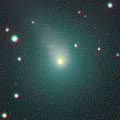
|
It brightened much faster than expected. Now it is so bright as 10.0 mag (Aug. 9, Juan Jose Gonzalez). In the Northern Hemisphere, it keeps observable at 11-13 mag in good condition until early 2013. Although it becomes extremely low in August, it will be getting higher again in the morning sky after September. In the Southern Hemisphere, it is not observable until late 2012.
Date(TT) R.A. (2000) Decl. Delta r Elong. m1 Best Time(A, h)
Aug. 18 9 44.63 48 1.1 2.912 2.161 34 12.8 5:12 (231,-33)
Aug. 25 9 49.80 45 46.0 2.918 2.175 35 12.9 5:04 (232,-29)
|
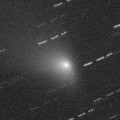
|
It approached to the sun down to 0.12 A.U. on July 14, and brightened up to 7.8 mag (July 22, Juan Jose Gonzalez). Now it is fading in the evening sky. But it is still bright as 10.2 mag (Aug. 9, Juan Jose Gonzalez). It will fade out rapidly in the evening low sky after this.
Date(TT) R.A. (2000) Decl. Delta r Elong. m1 Best Time(A, h)
Aug. 18 13 42.16 8 38.7 1.085 1.003 57 12.9 18:55 (127, 30)
Aug. 25 14 17.04 2 54.9 1.232 1.141 60 13.8 19:00 (123, 34)
|

|
Big asteroid discovered in 1906. It suddenly showed the cometary activity on Dec. 11, 2010, probably due to an impact of a small object. Now it is 11.9 mag (May 29, Marco Goiato). It has already turned to be stellar.
Date(TT) R.A. (2000) Decl. Delta r Elong. m1 Best Time(A, h)
Aug. 18 16 17.48 -27 40.6 2.062 2.478 101 13.6 18:55 (141, 81)
Aug. 25 16 24.08 -28 11.7 2.152 2.483 96 13.7 19:00 (118, 77)
|
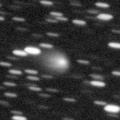
|
Now it is 13.8 mag (Aug. 19, Seiichi Yoshida). It keeps bright at 13-14 mag for a long time until 2014. It keeps observable for a long time in the Northern Hemisphere. It is not observable in the Southern Hemisphere.
Date(TT) R.A. (2000) Decl. Delta r Elong. m1 Best Time(A, h)
Aug. 18 22 2.42 56 43.6 5.790 6.212 110 13.7 0:17 (180, -2)
Aug. 25 21 50.75 56 7.7 5.733 6.196 112 13.7 23:33 (180, -1)
|

|
Now it is bright as 13.1 mag (July 27, Jakub Cerny). It keeps bright as 13-14 mag for a long time after this until 2013. It is not observable in the Northern Hemisphere, but it is observable in good condition in the Southern Hemisphere.
Date(TT) R.A. (2000) Decl. Delta r Elong. m1 Best Time(A, h)
Aug. 18 5 0.30 -53 42.9 5.611 5.710 90 13.7 5:12 (321, 62)
Aug. 25 5 0.81 -54 11.0 5.596 5.726 92 13.7 5:04 (325, 64)
|
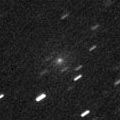
|
Now it is 15.4 mag (Aug. 11, Hidetaka Sato). However, it is extremely diffuse. The nuclear magnitude is fainter than 19 mag. Maybe the comet has been disintegrated, and will disappear soon. It keeps observable for a long time until December, but it keeps locating low in the evening after this.
Date(TT) R.A. (2000) Decl. Delta r Elong. m1 Best Time(A, h)
Aug. 18 13 21.27 14 3.5 1.834 1.436 51 13.9 18:55 (126, 22)
Aug. 25 13 40.65 11 8.5 1.806 1.394 50 13.7 19:00 (122, 22)
|

|
First return of a new periodic comet which brightened up to 14 mag in 2005. Now it is bright as 13.0 mag (Aug. 19, Seiichi Yoshida). It will brighten up to 12-13 mag from summer to autumn, and will be observable in excellent condition.
Date(TT) R.A. (2000) Decl. Delta r Elong. m1 Best Time(A, h)
Aug. 18 1 37.71 9 18.1 0.745 1.522 119 13.9 3:51 (180, 46)
Aug. 25 1 46.22 12 57.4 0.702 1.510 122 13.7 3:32 (180, 42)
|

|
Now it is so bright as 11.5 mag (July 21, Carlos Labordena). It will be unobservable in late September in the Northern Hemisphere, or in mid October in the Southern Hemisphere. But it will be observable at 13-14 mag in good condition again in 2013.
Date(TT) R.A. (2000) Decl. Delta r Elong. m1 Best Time(A, h)
Aug. 18 15 23.33 -12 26.7 5.181 5.216 86 14.0 18:55 (136, 61)
Aug. 25 15 20.75 -12 36.7 5.322 5.226 79 14.0 19:00 (123, 56)
|

|
Now it is 13.3 mag (July 11, Jakub Cerny). It still locates high and will be observable until early September in the Southern Hemisphere. It is not observable already in the Northern Hemisphere.
Date(TT) R.A. (2000) Decl. Delta r Elong. m1 Best Time(A, h)
Aug. 18 12 31.17 -11 49.9 6.896 6.251 47 14.2 18:55 ( 96, 29)
Aug. 25 12 35.41 -12 13.0 6.971 6.250 41 14.2 19:00 ( 91, 23)
|

|
Now it is so bright as 12.3 mag (July 21, Carlos Labordena). It will be too low to observe in the evening sky soon. But it will be observable at 12-14 mag in good condition again in 2013. However, it locates somewhat low in the Northern Hemisphere in 2013.
Date(TT) R.A. (2000) Decl. Delta r Elong. m1 Best Time(A, h)
Aug. 18 13 38.24 -0 34.4 3.419 3.010 58 14.4 18:55 (118, 35)
Aug. 25 13 46.15 -1 51.0 3.484 2.999 53 14.5 19:00 (112, 31)
|

|
It kept as bright as 11-12 mag for a long time from 2011 autumn to 2012 spring. It is not observable now. But it will appear in the morning sky again at 15 mag in autumn.
Date(TT) R.A. (2000) Decl. Delta r Elong. m1 Best Time(A, h)
Aug. 18 8 28.58 14 18.6 3.558 2.628 19 14.8 5:12 (254, -2)
Aug. 25 8 40.31 13 30.9 3.555 2.660 23 14.8 5:04 (254, 0)
|

|
This comet brightened up to 10 mag in outburst in 1995, however, it became lost after that. The condition of this apparition is bad. It was not observable around the perihelion passage. But it is appearing in the morning sky now. However, it is not detected, fainter than 19.0 mag (Aug. 11, Hidetaka Sato).
Date(TT) R.A. (2000) Decl. Delta r Elong. m1 Best Time(A, h)
Aug. 18 6 42.70 12 42.3 2.578 2.005 45 14.8 5:12 (239, 19)
Aug. 25 6 55.81 12 13.0 2.573 2.057 49 15.1 5:04 (238, 20)
|

|
Now it is 14.5 mag (July 19, P. C. Sherrod). It is also visible visually at 13.8 mag (July 17, Juan Jose Gonzalez). It keeps observable in good condition at 14-15 mag for a long time until winter. It locates somewhat low in the Southern Hemisphere.
Date(TT) R.A. (2000) Decl. Delta r Elong. m1 Best Time(A, h)
Aug. 18 23 51.86 39 33.4 2.709 3.336 120 14.9 2:06 (180, 15)
Aug. 25 23 51.50 39 48.4 2.632 3.315 124 14.8 1:38 (180, 15)
|

|
Now it is 14.5 mag (July 17, Yasukazu Ikari). It is also visible visually at 14.2 mag (July 22, Juan Jose Gonzalez). It is expected to approach to the earth and to be observable at 9-10 mag in good condition in winter. The condition is good in the Northern Hemisphere. It locates low in the Southern Hemisphere, and will be unobservable after summer. But it will become observable in good condition after 2013 January.
Date(TT) R.A. (2000) Decl. Delta r Elong. m1 Best Time(A, h)
Aug. 18 15 33.80 47 0.6 1.875 1.931 77 15.2 18:55 (168, 7)
Aug. 25 15 20.07 46 5.9 1.885 1.853 72 15.1 19:00 (160, 5)
|

|
Now it is 14.8 mag (July 11, Jakub Cerny). In the Southern Hemisphere, it will be observable at 15-16 mag in good condition for a long time until 2013 summer. It is not observable at all in the Northern Hemisphere.
Date(TT) R.A. (2000) Decl. Delta r Elong. m1 Best Time(A, h)
Aug. 18 17 1.73 -82 5.4 3.498 3.891 105 15.1 19:14 ( 0, 43)
Aug. 25 16 41.80 -81 49.9 3.561 3.891 101 15.2 19:00 ( 2, 43)
|

|
Looks almost asteroidal. But it has a very faint tail. It passed near by the earth, and brightened up to 13.9 mag (July 22, Artyom Novichonok). Now it is fading, but still bright as 15.0 mag (Aug. 19, Seiichi Yoshida). It keeps observable in excellent condition in the Northern Hemisphere. It locates extremely low in the Southern Hemisphere.
Date(TT) R.A. (2000) Decl. Delta r Elong. m1 Best Time(A, h)
Aug. 18 19 10.32 44 6.6 0.881 1.574 112 15.2 21:18 (180, 11)
Aug. 25 18 39.37 43 20.7 1.016 1.628 106 15.6 20:21 (180, 12)
|

|
Now it is 14.6 mag (June 30, Jakub Cerny). Jakub Cerny reported the comet brightened in late July. It will be observable in good condition in the Southern Hemisphere while fading gradually after this. It will locate somewhat low in the Northern Hemisphere.
Date(TT) R.A. (2000) Decl. Delta r Elong. m1 Best Time(A, h)
Aug. 18 23 9.14 -25 47.1 2.576 3.533 157 15.8 1:24 (180, 81)
Aug. 25 23 5.56 -26 48.4 2.618 3.586 160 15.9 0:53 (180, 82)
|
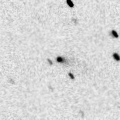
|
It brightened very rapidly. Now it is very bright as 15.8 mag (Aug. 17, Hiroshi Abe). It will approach to the earth down to 0.4 A.U., and will be observable in good condition as bright as 15 mag in September and October.
Date(TT) R.A. (2000) Decl. Delta r Elong. m1 Best Time(A, h)
Aug. 18 0 48.13 -13 25.3 0.595 1.502 136 16.1 3:02 (180, 68)
Aug. 25 0 48.82 -9 39.2 0.542 1.478 142 15.9 2:35 (180, 65)
|
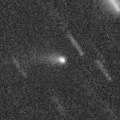
|
Now it is 16.6 mag (July 23, S. Shurpakov). It will brighten up to 15 mag from autum to winter. In the Northern Hemisphere, it keeps observable for a long time until the comet fades out. It is not observable in the Southern Hemisphere, except for 2013 spring, but the comet locates extremely low only.
Date(TT) R.A. (2000) Decl. Delta r Elong. m1 Best Time(A, h)
Aug. 18 13 56.43 73 37.6 2.869 2.690 69 16.6 18:55 (168,-22)
Aug. 25 13 45.64 72 19.0 2.839 2.649 68 16.5 19:00 (165,-23)
|

|
The condition of this apparition is bad, and it was not observable around the perihelion passage. Now it is 15.7 mag (June 30, Jakub Cerny). It will be fading after this, and will be fainter than 18 mag in late October.
Date(TT) R.A. (2000) Decl. Delta r Elong. m1 Best Time(A, h)
Aug. 18 2 10.26 3 20.9 2.042 2.615 113 16.5 4:24 (180, 52)
Aug. 25 2 10.04 3 11.9 1.998 2.653 120 16.6 3:56 (180, 52)
|
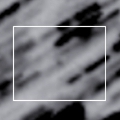
|
First return of a new periodic comet discovered in 1994. Brightening rapidly. Now it is 16.9 mag (Aug. 18, E. Bryssinck). It will brighten up to 13.5 mag and will be observable in good condition from autumn to winter.
Date(TT) R.A. (2000) Decl. Delta r Elong. m1 Best Time(A, h)
Aug. 18 19 27.27 31 57.5 1.152 1.907 123 17.0 21:38 (180, 23)
Aug. 25 19 21.77 31 18.9 1.112 1.845 120 16.7 21:05 (180, 24)
|
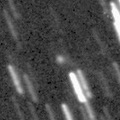
|
Now it is 16.5 mag (July 23, A. Diepvens). It is expected to brighten up to 10 mag from winter to spring in 2013. In the Northern Hemisphere, it keeps observable in good condition until 2013 April. It is not observable now in the Southern Hemisphere. It will become observable after 2013 April, but it keeps locating low.
Date(TT) R.A. (2000) Decl. Delta r Elong. m1 Best Time(A, h)
Aug. 18 1 48.94 84 48.4 3.660 3.616 79 16.9 4:04 (180,-30)
Aug. 25 2 1.91 86 7.7 3.555 3.548 81 16.8 3:50 (180,-31)
|
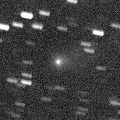
|
Now it is 16.8 mag (July 25, K. Hills). It tends to brighten after the perihelion passage. It keeps observable at 16-17 mag from 2012 to 2013. It locates somewhat low in the Northern Hemisphere.
Date(TT) R.A. (2000) Decl. Delta r Elong. m1 Best Time(A, h)
Aug. 18 16 14.86 -19 40.3 2.784 3.124 100 17.0 18:55 (156, 73)
Aug. 25 16 19.71 -20 11.3 2.880 3.127 94 17.1 19:00 (136, 71)
|
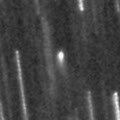
|
It approached to the earth down to 0.17 A.U. in July, and brightened up to 14.5 mag (July 13, Juan Jose Gonzalez). Now it is fading. It has already faded down to 17.3 mag (Aug. 18, E. Bryssinck). It keeps observable in good condition after this in the Northern Hemisphere. It locates low in the Southern Hemisphere.
Date(TT) R.A. (2000) Decl. Delta r Elong. m1 Best Time(A, h)
Aug. 18 19 41.45 36 56.1 0.344 1.228 121 17.1 21:53 (180, 18)
Aug. 25 19 52.45 38 14.3 0.388 1.254 120 17.4 21:37 (180, 17)
|
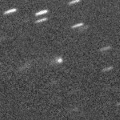
|
Now it is 17.4 mag (July 24, A. Diepvens). It keeps 17 mag for a long time from 2009 to 2013.
Date(TT) R.A. (2000) Decl. Delta r Elong. m1 Best Time(A, h)
Aug. 18 23 7.46 13 31.9 7.575 8.444 147 17.2 1:22 (180, 41)
Aug. 25 23 2.44 13 10.3 7.541 8.457 153 17.2 0:50 (180, 42)
|

|
It brightened up to 10 mag from autumn to winter in 2011. Now it is appearing in the morning sky again in the Southern Hemisphere. It has already faded down to 16.6 mag (June 30, Jakub Cerny). It keeps observable in good condition while fading graudlaly after this. It will be hardly observable in the Northern Hemisphere.
Date(TT) R.A. (2000) Decl. Delta r Elong. m1 Best Time(A, h)
Aug. 18 5 3.48 -27 20.4 4.367 4.314 80 17.2 5:12 (263, 62)
Aug. 25 5 5.06 -29 14.7 4.347 4.373 84 17.3 5:04 (263, 67)
|
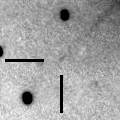
|
It was observed at 17 mag in 2011 autumn. It will be observable at 17 mag in good condition again from autumn to winter in 2012. It locates low in the Southern Hemisphere.
Date(TT) R.A. (2000) Decl. Delta r Elong. m1 Best Time(A, h)
Aug. 18 5 48.72 18 41.6 3.324 2.919 58 17.3 5:12 (224, 23)
Aug. 25 5 57.56 19 28.8 3.253 2.930 62 17.2 5:04 (221, 24)
|
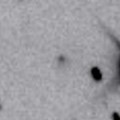
|
First return of a new periodic comet discovered in 2005. Now it is 16.7 mag (Aug. 16, Yasukazu Ikari). It will be observable in excellent condition at 17-18 mag until November.
Date(TT) R.A. (2000) Decl. Delta r Elong. m1 Best Time(A, h)
Aug. 18 23 31.22 5 7.9 1.278 2.208 149 17.5 1:46 (180, 50)
Aug. 25 23 28.18 5 24.5 1.240 2.202 155 17.4 1:15 (180, 50)
|

|
Now it is 17.4 mag (July 24, Siding Spring Survey). It keeps 17.5 mag until September. It is observable in excellent condition in the Southern Hemisphere. But it locates somewhat low in the Northern Hemisphere.
Date(TT) R.A. (2000) Decl. Delta r Elong. m1 Best Time(A, h)
Aug. 18 21 35.43 -26 26.3 0.598 1.599 166 17.4 23:46 (180, 81)
Aug. 25 21 30.83 -23 12.6 0.607 1.602 163 17.5 23:14 (180, 78)
|
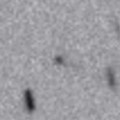
|
Although it was extremely faint as 20.0 mag on May 27 (Hidetaka Sato), it brightened rapidly. Now it is 17.4 mag (Aug. 16, Yasukazu Ikari). It keeps observable in good condition at 17 mag from summer to autumn.
Date(TT) R.A. (2000) Decl. Delta r Elong. m1 Best Time(A, h)
Aug. 18 23 44.94 1 36.1 1.154 2.083 147 17.7 1:59 (180, 53)
Aug. 25 23 40.57 2 54.0 1.116 2.076 154 17.6 1:28 (180, 52)
|
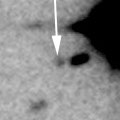
|
Now it is 18.0 mag (May 27, K. Hills). In the Southern Hemisphere, it keeps observable at 17 mag in good condition for a long time from 2012 to 2013. It is not observable at all in the Northern Hemisphere.
Date(TT) R.A. (2000) Decl. Delta r Elong. m1 Best Time(A, h)
Aug. 18 6 56.93 -46 2.9 5.257 5.017 70 17.6 5:12 (303, 44)
Aug. 25 7 0.78 -47 41.8 5.209 5.002 72 17.6 5:04 (305, 47)
|

|
It was observed at 12.5 mag on Apr. 1, as bright as expected (Michael Jager). However, it has faded very rapidly. Hidetaka Sato reported that it has been already too faint to catch, fainter than 19.0 mag on June 25. In the Northern Hemisphere, it will be high after this. In the Southern Hemisphere, it will never be observable again.
Date(TT) R.A. (2000) Decl. Delta r Elong. m1 Best Time(A, h)
Aug. 18 5 30.20 47 4.7 3.426 3.110 63 19.9 5:12 (205, 1)
Aug. 25 5 38.03 47 20.7 3.415 3.182 68 20.1 5:04 (203, 2)
|
|
![]()
 C/2012 J1 ( Catalina )
C/2012 J1 ( Catalina ) C/2012 K5 ( LINEAR )
C/2012 K5 ( LINEAR ) C/2011 O1 ( LINEAR )
C/2011 O1 ( LINEAR ) P/2012 NJ ( La Sagra )
P/2012 NJ ( La Sagra ) C/2011 A3 ( Gibbs )
C/2011 A3 ( Gibbs ) 168P/Hergenrother
168P/Hergenrother C/2012 L1 ( LINEAR )
C/2012 L1 ( LINEAR ) 71P/Clark
71P/Clark 262P/2012 K7 ( McNaught-Russell )
262P/2012 K7 ( McNaught-Russell ) C/2012 L2 ( LINEAR )
C/2012 L2 ( LINEAR ) 152P/Helin-Lawrence
152P/Helin-Lawrence 189P/NEAT
189P/NEAT C/2008 S3 ( Boattini )
C/2008 S3 ( Boattini ) C/2010 G2 ( Hill )
C/2010 G2 ( Hill ) P/2011 N1 ( ASH )
P/2011 N1 ( ASH ) 261P/2012 K4 ( Larson )
261P/2012 K4 ( Larson ) P/2012 O3 ( McNaught )
P/2012 O3 ( McNaught ) 160P/LINEAR
160P/LINEAR C/2012 C1 ( McNaught )
C/2012 C1 ( McNaught ) C/2011 Q2 ( McNaught )
C/2011 Q2 ( McNaught )![]()



































